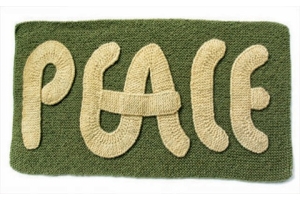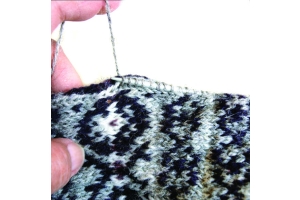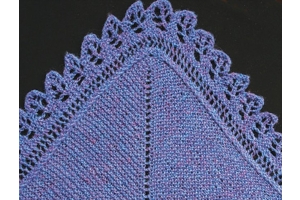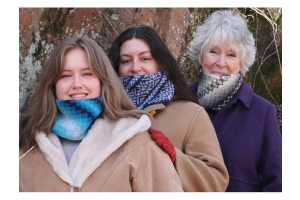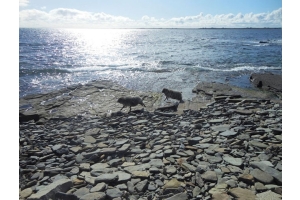Blog #22 Meg Swansen on the Surprise Pattern & Steeks
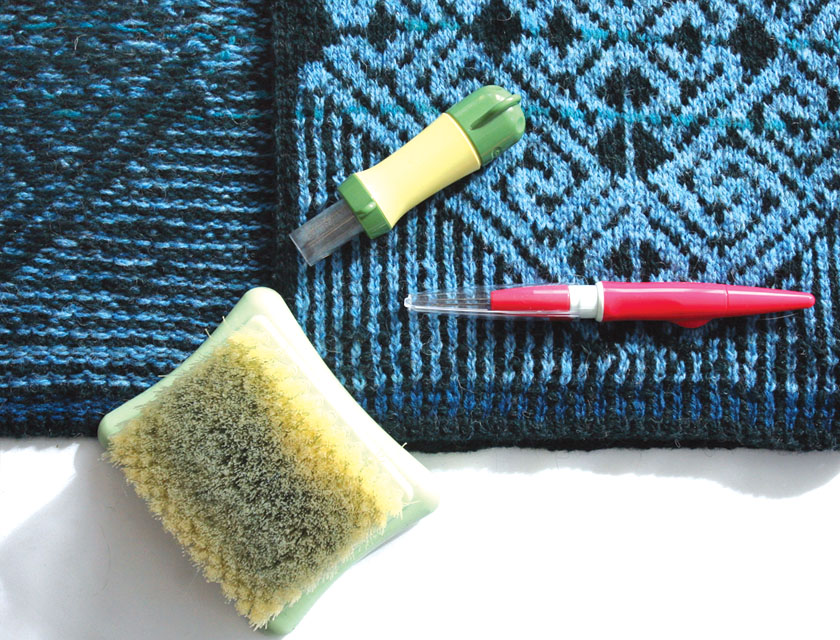
A Celebration of the Surprise pattern and Needle-Felted Steeks!
Elizabeth Zimmermann's Surprise Pattern: Fifty years (and one month) ago, our son Cully was born. At approximately the same time, we also celebrated the publication of the Baby Surprise Jacket (BSJ) designed for Cully by his grandmother, Elizabeth Zimmermann.
As Cully’s interest in knitting, designing, and writing grew, so did his fascination with the geometry of the BSJ - then the ASJ (Adult Surprise Jacket); especially by the difficulty many knitters had with the upper arm depth (being too shallow). Since the upper arm depth was integrated into the whole design, we tried several solutions, but none of them worked for everyone.
Eventually, Cully figured out a way to separate that measurement from the rest of the Origami construction, and invented the Surprise Calculator, which results in detailed instructions for any size at any gauge, and makes the armhole depth a custom measurement.
Cully's book, The Complete Surprise, includes his new innovations, plus his designs for a baby snuggle-suit, a little girl’s dress, and a child or adult’s circular-stranded Surprise Jacket.
The popularity of the Baby Surprise Jacket has continued to grow, and Cully's interest has not waned. Now, Cully has designed a pair of Surprise Vests, which, similar to the BSJ, capture the exciting transformation that - with a couple of folds - turns a mysterious mass of knitting into a beautiful garment.
One puzzle is a simply knit Garter Stitch Surprise Vest. No steeks - only a couple of increase points (like the BSJ itself) and the mystery grows throughout the knitting; then, voila - a cozy, attractive vest.
The second puzzle, the elegant Fair Isle Surprise Vest, is truly revolutionary for Fair Isle construction. The beautiful OXOs and Peeries of a traditional Fair Isle are led on a surprising path during the knitting, resulting in a puzzle that, when folded and woven, reveals a striking mitered-front. For this construction, knitters will need to steek at three points, but now with less worry. Steeking has become even easier than ever.
Needle-Felted Steeks
When I began knitting many decades ago, the standard method to produce a classic Norwegian style sweater was to knit it entirely in the round, machine-stitch the armholes (and center-front for a cardigan) to secure the stitches, then cut them open. When Sheila McGregor’s Fair Isle book was published, we were introduced to the word “steek” which instructed us to cast on additional stitches to provide a field for the future cutting. Then a Knitting Camper came up with the crochet-method to guard against cut stitches ravelling. See Blog #10 for a demonstration.
NOW, there is yet another evolutionary step presented to knitters, taught to me by Gretchen Funk during one of our Knitting Camps. So captivated am I by this logical new method to secure a steek prior to cutting, that (with Gretchen’s approval) I asked Cully to film a quick video for you. I had done a bit of needle-felting a few decades ago, but the tools at the time were more primative, and I had never thought of this brilliant application.
After Gretchen’s brief yet thorough demonstration, there was an unusual silence through the room of about 60 other knitters: we were all familiar with steeks, but stunned speechless by this simple new idea. A bunch of us ordered felting tools that very afternoon. This is a typical example of what happens at our Knitting Camps; the collaboration between participants enlightens us all.
Knitting Camper Gretchen Funk teaches classes at The Yarnery in Minneapolis* and for this new concept, Gretchen gives credit to her friend Alice Adams from Duluth. I am grateful to them both.
Since August, I have finished three sweaters knitted with our Shetland Jumperweight, Unspun Icelandic, and Canadian Regal wools. The steeks in all three types of wool felted beautifully. The advantage of eliminating both crocheting and machine-stitching certainly overrides the minor drawback of a slightly thicker facing (due to the felting).
I keep my felting tools in a small cloth bag - within easy reach from my knitting sofa. My tools consist of a brush/platform (upon which you place the knitted steek to be secured; the brush receives the ferociously sharp felting needles), a 3-pronged felting needle, and a 5-pronged felting needle, just as Gretchen used for her demonstration.
*Twin Cities or nearby knitters can sign up now for Gretchen’s needle-felted-steeks workshop, January 5th, 2019 @ The Yarnery.
Ruth, you can purchase the felting items on Amazon, but please check if you have a nearby yarn store if they can order them for you. They are all produced by the Clover company.

